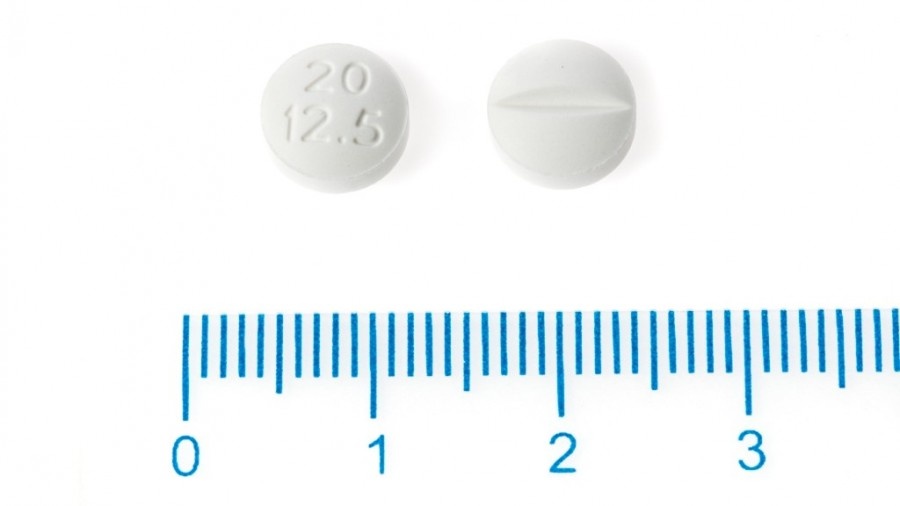

BARIPRIL DIU 20 mg/12.5 mg TABLETS

Ask a doctor about a prescription for BARIPRIL DIU 20 mg/12.5 mg TABLETS

How to use BARIPRIL DIU 20 mg/12.5 mg TABLETS
Introduction
Package Leaflet: Information for the User
Baripril Diu 20 mg/12.5 mg Tablets
Enalapril/Hydrochlorothiazide
Read all of this leaflet carefully before you start taking this medicine because it contains important information for you.
- Keep this leaflet, you may need to read it again.
- If you have any further questions, ask your doctor or pharmacist.
- This medicine has been prescribed for you only. Do not pass it on to others. It may harm them, even if their signs of illness are the same as yours.
- If you get any side effects, talk to your doctor or pharmacist. This includes any possible side effects not listed in this leaflet. See section 4.
Contents of the pack:
- What Baripril Diu is and what it is used for
- What you need to know before you take Baripril Diu
- How to take Baripril Diu
- Possible side effects
- Storage of Baripril Diu
- Contents of the pack and other information
1. What Baripril Diu is and what it is used for
This medication contains two active ingredients, enalapril and hydrochlorothiazide, which belong to the group of antihypertensives and, through different mechanisms, reduce high blood pressure.
The enalapril component of Baripril Diu is a medication that belongs to a group of medications known as angiotensin-converting enzyme inhibitors (ACE inhibitors), which acts by dilating blood vessels to make the heart pump blood to all parts of the body more easily. The hydrochlorothiazide component of Baripril Diu belongs to the group of medications known as thiazide diuretics (medications that increase urine elimination). Together, enalapril and hydrochlorothiazide help decrease high blood pressure.
Your doctor has prescribed Baripril Diu to treat hypertension (high blood pressure) because it is not adequately controlled with enalapril or an ACE inhibitor alone.
2. What you need to know before taking Baripril Diu
Do not takeBaripril Diu
- If you are allergic (hypersensitive) to enalapril, hydrochlorothiazide, or any of the other components of Baripril Diu.
- If you are allergic to sulfonamide-derived substances. Ask your doctor if you are not sure what sulfonamide-derived medications are.
- If you have been previously treated with a medication from the same group as Baripril Diu (ACE inhibitors) and have had allergic reactions with swelling of the face, lips, tongue, and/or throat with difficulty swallowing or breathing.
- If you have had such allergic reactions without a known cause or if you have been diagnosed with hereditary or idiopathic angioedema (a disease that causes inflammation in the face and respiratory tract, and abdominal colic).
- If you have severe liver disease.
- If you have severe kidney disease.
- If you have anuria (do not urinate).
- If you have diabetes or kidney failure and are being treated with a medication to lower blood pressure that contains aliskiren.
- If you are pregnant more than 3 months (it is also best to avoid Baripril Diu at the beginning of pregnancy - see section on pregnancy).
If you are not sure if you should start taking Baripril Diu, consult your doctor.
Warnings and precautions
Consult your doctor or pharmacist before starting to take Baripril Diu
- If you have had skin cancer or if an unexpected skin lesion appears during treatment. Treatment with hydrochlorothiazide, especially long-term use at high doses, may increase the risk of certain types of skin and lip cancer (non-melanoma skin cancer). Protect your skin from sun and UV exposure while taking Baripril Diu.
- If you experience a decrease in vision or eye pain, they could be symptoms of fluid accumulation in the vascular layer of the eye (choroidal effusion) or an increase in eye pressure and can occur within a few hours to a week after taking Baripril Diu.
- If you have had respiratory or pulmonary problems (such as inflammation or fluid in the lungs) after taking hydrochlorothiazide in the past. If you experience shortness of breath or severe difficulty breathing after taking Baripril Diu, seek medical attention immediately.
In the following situations, your doctor may need to adjust the dose of Baripril Diu or monitor your potassium levels in the blood:
- If you have heart disease with narrowing of the heart valves (mitral or aortic stenosis) or other factors that reduce left ventricular outflow (hypertrophic cardiomyopathy).
- If you have disorders that reduce fluid volume or sodium levels in the body (e.g., severe vomiting, diarrhea, or if you are being treated with high doses of diuretics).
- If you have any blood disorders.
- If you have diabetes and are taking medications to treat diabetes, including insulin, as a dose adjustment of the medications used to treat diabetes may be necessary. Diabetes can cause high potassium levels in the blood, which can be serious.
- If you have liver problems.
- If you have kidney problems (including kidney transplant), as they can cause high potassium levels in the blood, which can be serious.
- If you are undergoing dialysis.
- If you follow a salt-free diet, take potassium supplements, potassium-sparing medications (medications that increase urine elimination), or salt substitutes that contain potassium.
- If an allergic reaction with swelling of the face, lips, tongue, and/or throat with difficulty swallowing or breathing occurs during treatment. You should be aware that black patients are more sensitive to this type of medication.
- If you are about to undergo a treatment called LDL apheresis (a procedure similar to dialysis to remove LDL or bad cholesterol from the blood in cases where it is excessively elevated).
- If you are going to undergo desensitization treatment to reduce the effect of an allergy to bee or wasp stings.
- If you have low blood pressure, as the use of Baripril Diu, especially in the first doses, can cause a sudden drop in blood pressure (you may notice dizziness or lightheadedness, especially when standing up).
- If you are taking any of the following medications used to treat high blood pressure (hypertension):
- an angiotensin II receptor antagonist (ARA) (also known as "sartans", e.g., valsartan, telmisartan, irbesartan), especially if you have kidney problems related to diabetes.
- aliskiren
Your doctor may need to check your kidney function, blood pressure, and electrolyte levels in the blood (e.g., potassium) at regular intervals.
See also the information under the heading "Do not take Baripril Diu tablets".
Before undergoing surgery or anesthesia (even at the dentist's office), inform your doctor or dentist that you are taking Baripril Diu, as you may experience a sudden drop in blood pressure due to anesthesia.
You should inform your doctor if you think you are pregnant (or might be). Your doctor will normally advise you to stop taking Baripril Diu before becoming pregnant or as soon as you know you are pregnant and will advise you to take a different medication instead of Baripril Diu. Baripril Diu is not recommended during pregnancy and should not be taken if you are pregnant more than 3 months, as it can cause serious harm to your baby if used from the third month of pregnancy.
Taking Baripril Diu withother medications
Tell your doctor or pharmacist if you are using or have recently used any other medications, including those obtained without a prescription, homeopathic, herbal, or other health-related products, as your doctor may need to modify your dose and/or take other precautions.
It is especially important that you inform your doctor if you are using or have recently used any of the following medications:
- An angiotensin II receptor antagonist (ARA) or aliskiren (see also the information under the headings "Do not take Baripril Diu" and "Warnings and precautions").
Taking Baripril Diu with food, drinks, and alcohol
Baripril Diu can be taken before or after meals.
Alcohol can increase the blood pressure-lowering effect of this medication.
Pregnancy and breastfeeding
If you are pregnant or breastfeeding, think you may be pregnant, or are planning to have a baby, ask your doctor or pharmacist for advice before taking this medication.
Pregnancy
You should inform your doctor if you think you are pregnant (or might be). Normally, your doctor will advise you to stop taking Baripril Diu before becoming pregnant or as soon as you know you are pregnant and will advise you to take a different medication instead of Baripril Diu. Baripril Diu is not recommended during pregnancy and should not be taken if you are pregnant more than 3 months, as it can cause serious harm to your baby if used from the third month of pregnancy.
Breastfeeding
Tell your doctor if you are breastfeeding or about to start breastfeeding. Baripril Diu is not recommended for mothers who are breastfeeding.
The two active ingredients of Baripril Diu, enalapril and hydrochlorothiazide, pass into breast milk. If you are breastfeeding or plan to breastfeed, consult your doctor.
Use in children and adolescents
The safety and efficacy of Baripril Diu in this population have not been established, so its use is not recommended in children.
Use in the elderly
In studies where enalapril and hydrochlorothiazide were taken together, the effect of the medications and tolerability were similar in young adult and elderly patients with high blood pressure.
Use in athletes
Athletes are informed that this medication contains a component that can produce a positive result in doping tests.
Driving and using machines
It is unlikely that Baripril Diu will affect your ability to drive or use machines. However, dizziness or fatigue can occasionally occur during treatment of high blood pressure, especially at the beginning. If you experience such effects, you should consult your doctor before performing these activities.
Baripril Diu contains lactose and sodium
This medication contains lactose. If your doctor has told you that you have an intolerance to some sugars, consult with them before taking this medication.
This medication contains less than 23 mg of sodium (1 mmol) per tablet; it is essentially "sodium-free".
Interference with diagnostic tests
If you are to undergo any diagnostic tests to assess parathyroid gland function, inform your doctor that you are being treated with Baripril Diu, as it may alter the test results.
3. How to take Baripril Diu
Follow exactly the administration instructions of Baripril Diu indicated by your doctor. In case of doubt, consult your doctor or pharmacist.
Remember to take your medication.
Your doctor will decide the appropriate dose, depending on your condition and whether you are taking other medications.
The normal dose is one or two tablets administered once a day. Take Baripril Diu every day, exactly as indicated by the doctor. It is very important to continue taking this medication for the time recommended by the doctor. Do not take more tablets than the prescribed dose.
The initial dose may cause a greater drop in blood pressure than what will occur after continued treatment. You may notice dizziness or lightheadedness, and lying down could help. If you are concerned, consult your doctor.
Use in patients with impaired kidney function
If you have any kidney disease, your doctor will indicate the most suitable dose.
Method of administration
This medication is administered orally.
Take the Baripril Diu tablets with the help of a glass of water. Baripril Diucan be taken before or after meals.
If you take moreBaripril Diuthan you should
If you have taken more Baripril Diu than you should, consult your doctor or pharmacist immediately or call the Toxicology Information Service, telephone 91 562 04 20, indicating the medication and the amount taken.
It is recommended to take the package and the package leaflet of the medication to the healthcare personnel.
The most likely symptoms would be dizziness or vertigo due to a sudden or excessive drop in blood pressure and/or excessive thirst, disorientation, decreased urine production, and/or tachycardia.
If you forget to takeBaripril Diu
You should take BARIPRIL DIU as indicated by your doctor.
Do not take a double dose to make up for forgotten doses. Just take the next dose as usual.
If you stop takingBaripril Diu
Your doctor will indicate the duration of your treatment with Baripril Diu. Do not stop treatment before, even if you feel better.
If you have any further questions on the use of this product, ask your doctor or pharmacist.
4. Possible Adverse Effects
Like all medicines, Baripril Diu can cause adverse effects, although not all people suffer from them.
The recorded adverse effects are detailed below according to the following frequencies:
Very frequent(may affect more than 1 in 10 people)
Frequent(may affect up to 1 in 10 people)
Uncommon(may affect up to 1 in 100 people)
Rare(may affect up to 1 in 1000 people)
Very rare(may affect up to 1 in 10,000 people)
Unknown frequency: (cannot be estimated from available data)
Blood and lymphatic system disorders:
uncommon: decrease in red blood cells (cells that carry oxygen in the blood)
rare: reduction of a type of white blood cell (neutrophils), decrease in hemoglobin (protein in red blood cells that carries oxygen), decrease in platelet count, decrease in hematocrit (proportion of red blood cells in the blood), decrease in white blood cell count, bone marrow depression (decrease in the body's ability to form blood cells), lymph node inflammation, immune system disorders.
Endocrine disorders:
unknown: syndrome of inappropriate antidiuretic hormone secretion (SIADH).
Metabolic and nutritional disorders:
frequent: high potassium levels in the blood, increased cholesterol, increased triglycerides, increased uric acid in the blood
uncommon: low glucose and magnesium levels in the blood, gout
rare: increased glucose in the blood
very rare: high calcium levels in the blood
Nervous system disorders:
frequent: headache, syncope, altered taste
uncommon: confusion, somnolence, insomnia, tingling sensation, vertigo
rare: paralysis (due to low potassium levels).
Psychiatric disorders:
Frequent: depression
uncommon: nervousness, decreased libido*
rare: abnormal dreams, sleep disorders.
Eye disorders:
very frequent: blurred vision.
unknown frequency: decreased vision or eye pain due to high pressure [possible signs of fluid accumulation in the vascular layer of the eye (choroidal effusion) or acute angle-closure glaucoma].
Ear and labyrinth disorders:
uncommon: ringing in the ears.
Cardiac and vascular disorders:
very frequent: dizziness
frequent: low blood pressure associated with fainting, heart rhythm disorders, chest pain, tachycardia (rapid heartbeats)
uncommon: flushing, palpitations (rapid and irregular heartbeat),
myocardial infarction or stroke, possibly secondary to excessive blood pressure reduction in high-risk patients (see section Take special care with Baripril Diu)
rare: changes in skin color of fingers and toes, nose, or ears (Raynaud's phenomenon).
Respiratory, thoracic, and mediastinal disorders:
very frequent: cough
frequent: difficulty breathing
uncommon: mucus secretion, sore throat and hoarseness, bronchospasm
(difficulty breathing) and asthma
rare: pulmonary infiltrates, respiratory distress (including pneumonia and pulmonary edema), inflammation of the nasal mucosa, allergic alveolitis (inflammation of the pulmonary alveolus
due to allergy)/eosinophilic pneumonia (disease in which a type of white blood cell, called eosinophils, accumulates in the lungs).
very rare: acute respiratory distress (signs include severe difficulty breathing, fever, weakness, and confusion).
Gastrointestinal disorders:
very frequent: nausea
frequent: diarrhea, abdominal pain
uncommon: intestinal obstruction with severe pain, pancreatitis, vomiting, digestive discomfort, constipation, loss of appetite, gastric irritation, dry mouth, peptic ulcer, flatulence (gas)*
rare: infection or inflammation of the mouth mucosa, tongue inflammation
very rare: intestinal angioedema (inflammation of the intestinal wall).
Hepatobiliary disorders:
rare: liver failure, liver necrosis (which can be fatal), liver inflammation, suppression or cessation of bile secretion, yellowing of the skin or eyes,
inflammation of the gallbladder (especially in patients with pre-existing bile duct stone formation).
Skin and subcutaneous tissue disorders:
frequent: skin rash (exanthema)
hypersensitivity/angioneurotic edema: swelling of the face, limbs, lips, tongue, glottis, and/or larynx
uncommon: excessive sweating, itching, urticaria, hair loss
rare: skin redness, severe blistering or bleeding in the skin (Stevens-Johnson syndrome), severe skin rash with skin and hair loss, skin peeling, appearance of red spots on the skin, skin alteration, skin redness, blistering on the skin, Stevens-Johnson syndrome.
unknown frequency: skin and lip cancer (non-melanoma skin cancer).
A symptomatic complex has been observed that may include some of the following reactions: fever, serositis, vasculitis, muscle inflammation/pain, joint inflammation/pain, positive antinuclear antibody test, increased erythrocyte sedimentation rate, eosinophilia, and leukocytosis. Skin rash, sun sensitivity, or other skin manifestations may also occur.
Musculoskeletal, connective tissue, and bone disorders:
frequent: muscle cramps †
uncommon: joint pain *
Renal and urinary disorders:
uncommon: renal dysfunction (alteration of kidney function), renal failure, presence of protein in the urine
rare: inadequate urine secretion, inflammation of kidney cells.
Reproductive system and breast disorders:
uncommon: impotence
rare: increased breast size in men.
General disorders and administration site conditions:
very frequent: fatigue
frequent: chest pain, fatigue
uncommon: general malaise, fever.
Investigations:
frequent: high potassium levels in the blood, increased serum creatinine
uncommon: increased blood urea, low sodium levels in the blood
rare: increased liver enzymes, increased serum bilirubin.
- Only observed with hydrochlorothiazide doses of 12.5 mg and 25 mg, as found in
Baripril Diu
† The frequency of muscle spasms as "frequent" applies to hydrochlorothiazide doses of 12.5 mg and 25 mg, as found in Baripril Diu, although the frequency of the event is "uncommon".
If you consider that any of the adverse effects you are experiencing is serious or if you notice any adverse effect not mentioned in this prospectus, inform your doctor or pharmacist.
Reporting of adverse effects:If you experience any type of adverse effect, consult your doctor or pharmacist, even if it is a possible adverse effect that does not appear in this prospectus. You can also report them directly through the Spanish Pharmacovigilance System for Human Use Medicines: https://www.notificaram.es. By reporting adverse effects, you can contribute to providing more information on the safety of this medicine.
5. Storage of Baripril Diu
Keep out of the reach and sight of children.
Do not use this medicine after the expiration date that appears on the packaging after CAD. The expiration date is the last day of the month indicated.
No special storage conditions are required.
Medicines should not be thrown down the drain or into the trash. Deposit the packaging and medicines you no longer need in the SIGRE Point of the pharmacy. In case of doubt, ask your pharmacist how to dispose of the packaging and medicines you no longer need. This way, you will help protect the environment.
6. Package Contents and Additional Information
Composition ofBaripril Diu
The active ingredients are enalapril, in the form of maleate, and hydrochlorothiazide. Each tablet contains 20 mg of enalapril and 12.5 mg of hydrochlorothiazide.
The other components are lactose monohydrate (lactose), sodium hydrogen carbonate (E-500), corn starch, pregelatinized corn starch (corn starch), magnesium stearate (E-470b), and yellow iron oxide (E-172).
Appearance of the Product and Package Contents
Baripril Diu is presented in packages of 28 tablets. The tablets are biconvex, elongated, yellow, and scored on one of their faces.
The score serves to fractionate and facilitate swallowing but not to divide into equal doses.
Marketing Authorization Holder and Manufacturer
Marketing Authorization Holder
Neuraxpharm Spain, S.L.U.
Avda. Barcelona 69
08970 Sant Joan Despí
Barcelona – Spain
Manufacturer
Neuraxpharm Pharmaceuticals, S.L.
Avda. Barcelona, 69
08970 Sant Joan Despí (Barcelona)
Spain
Date of the Last Revision of this Prospectus: September 2022
Detailed and updated information on this medicine is available on the website of the Spanish Agency for Medicines and Health Products (AEMPS) http://www.aemps.gob.es/.

How much does BARIPRIL DIU 20 mg/12.5 mg TABLETS cost in Spain ( 2026)?
The average price of BARIPRIL DIU 20 mg/12.5 mg TABLETS in January, 2026 is around 1.84 EUR. Prices may vary depending on the region, pharmacy, and whether a prescription is required. Always check with a local pharmacy or online source for the most accurate information.
- Country of registration
- Average pharmacy price1.84 EUR
- Active substance
- Prescription requiredYes
- Manufacturer
- This information is for reference only and does not constitute medical advice. Always consult a licensed doctor before taking any medication. Oladoctor is not responsible for medical decisions based on this content.
- Alternatives to BARIPRIL DIU 20 mg/12.5 mg TABLETSDosage form: TABLET, 20/12.5 mg/mgActive substance: enalapril and diureticsManufacturer: Alfasigma Espana S.L.Prescription requiredDosage form: TABLET, 20/12.5 mg/mgActive substance: enalapril and diureticsManufacturer: Aristo Pharma Iberia S.L.Prescription requiredDosage form: TABLET, 20/12.5 mg/mgActive substance: enalapril and diureticsManufacturer: Organon Salud S.L.Prescription required
Alternatives to BARIPRIL DIU 20 mg/12.5 mg TABLETS in other countries
The best alternatives with the same active ingredient and therapeutic effect.
Alternative to BARIPRIL DIU 20 mg/12.5 mg TABLETS in Ukraine
Online doctors for BARIPRIL DIU 20 mg/12.5 mg TABLETS
Discuss dosage, side effects, interactions, contraindications, and prescription renewal for BARIPRIL DIU 20 mg/12.5 mg TABLETS – subject to medical assessment and local rules.










